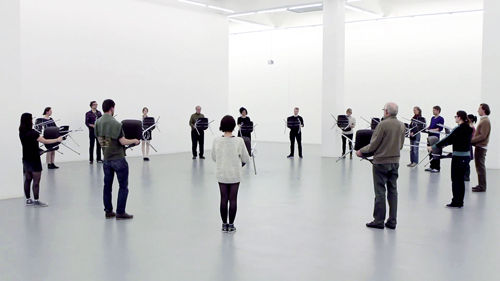Christian Falsnaes
Just do it
Just do it

‘If they haven’t been bought, they don’t exist,’ claimed the press release for Christian Falsnaes’s exhibition Performance works at Berlin’s PSM Gallery last autumn. ‘They’ were the artworks ‘exhibited’ in the show. ‘They’ included a piece titled Fulfilling Your Expectations that was only performed when it had been paid for – and even then only once, and only in front of the buyer. There were also drawings by Falsnaes that must be redrawn by the person wishing to buy them, after which the original would be burned. The burning is documented in photographs. The work thus acquired, titled Time/Line/Movement, consists of the documentation plus the drawing made by the buyer.
This may seem mean, but Falsnaes’s works are meaner still when actually performed. In 2013, when invited to be part of the group show Her Story(s) at Bonner Kunstverein, he rounded up male and female artists, critics, collectors and art lovers with ties to the Kunstverein. Inside the gallery space, he played master of ceremonies, encouraging them to dance, shout, throw their hands in the air and feel good – capturing the whole event on video. It is amazing how the assembled company plays along. They all obey their host unquestioningly, like lemmings. The artist becomes a kind of magician, capable of effortlessly directing his audience who do his bidding with a smile. There are moments when the absurd submissiveness documented in the video becomes almost unbearable. The performance’s title Männliches Auftreten als Folge gesellschaftlicher Machtverhältnisse zwischen Künstler und Publikum (Masculine demeanor as a consequence of social power relations between artist and audience 2013) is an allusion to Marianne Wex’s 1979 show „Weibliche“ und „männliche“ Körpersprache als Folge gesellschaftlicher Machtverhältnisse zwischen Mann und Frau (‘Feminine’ and ‘Masculine’ Body Language as a Result of Societal Power Relations Between Men and Women) in which she explored the structural differences between male and female body language.

Falsnaes – whose first institutional solo show is on view at the Kunstverein Bielefeld until April 2015 – himself admits he is sometimes surprised at how easily the art public allows itself to be manipulated. Rather cynically, he also sometimes refers to this public as the raw material for his performances. But this is his theme: the relation of the (in this case male) artist to his audience and vice versa. For years, contemporary art has been engaging critically with the power wielded by institutions, collectors and critics – but the power wielded by artists has usually been left out of the picture. Performance-based approaches in particular, though originally intended as emancipatory, often bring out authoritarian behaviour in artists (see Joseph Beuys for a male example and Marina Abramovicc` for a female one).
Highlighting and testing the willingness of an art public to submit to the authority of the artist is one aspect of Falsnaes’s performances; the question of the individuality of the artist (and the originality of his works) is another. This is reflected in the above-mentioned drawings made by the buyer. But it was especially clear in the performance One that took place at Cologne’s Galerie DREI in 2013. To begin with, the gallery walls were hung with a number of empty canvases. Falsnaes stood around, chatting informally with the visitors as they arrived. Suddenly, he grabbed some brushes and tubes of paint, pressed them into the hands of several of the people standing around, and asked them to paint the canvases. Hesitantly they began following his instructions – cheered on by Falsnaes, and soon by the rest of the audience. The mood became euphoric, the canvases fuller and fuller. The end results were ‘finished’ pictures, dirty floors, paint marks on the walls, and a littering of empty tubes. Those entering the gallery after the opening saw canvases done in the style of Abstract Expressionism and the aftermath of a frenzy of painting, accompanied by a recording of the performance. Pictures, traditionally understood as an unmediated expression of artistic ‘genius’, were made here in a collective procedure initiated by the artist. Besides the painted canvases, there remains a troublesome question: who is the author of these works?
Translated by Nicholas Grindell















